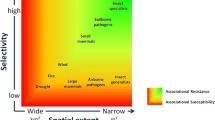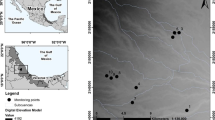Abstract
Extreme climatic events have the potential to affect plant communities around the world, and especially in the Mediterranean basin, where the frequency of milder and drier summers is expected to be altered under a global-change scenario. We experimentally investigated the effect of three contrasting climatic scenarios on the diversity and abundance of the natural woody-recruit bank among three characteristic habitats in a Mediterranean-type ecosystem: forest, shrubland, and bare soil. The climatic scenarios were dry summers (30% summer rainfall reduction), wet summers (simulating summer storms), and current climatic conditions (control). Seedling emergence and survival after the first summer was recorded during 4 consecutive years. The wet summer boosted abundance and diversity at emergence and summer survival, rendering the highest Shannon H′ index. By contrast, the dry summer had no effect on emergence, although survival tended to decline. Nonetheless, the habitat had a key role, bare soil showing almost null recruitment whatever the climatic scenario, and forest keeping the highest diversity in all of them. Our results show that recruit-bank density and diversity depends heavily on extreme climatic events. Community dynamics will depend not only on increased drought but also on the balance between dry and wet years.




Similar content being viewed by others
References
Agrawal AA, Ackerly DD, Adler F, Arnold AE, Caceres C, Doak DF, Post E, Hudson PJ, Maron J, Mooney KA, Power M, Schemske D, Stachowicz J, Strauss S, Turner MG, Werner E. 2007. Filling key gaps in population and community ecology. Frontiers Ecol Environ 5:145–52.
Allen CD, Breshears DP. 1998. Drought-induced shift of a forest-woodland ecotone: rapid landscape response to climate variation. Proc Natl Acad Sci USA 95:14839–42.
Allen CD, Macalady AK, Chenchouni H, Bachelet D, McDowell N, Vennetier M, Kitzberger T, Rigling A, Breshears DD, Hogg EH, Gonzalez P, Fensham R, Zhang Z, Castro J, Demidova N, Lim JH, Allard G, Running SW, Semerci A, Cobb N. 2010. A global overview of drought and heat-induced tree mortality reveals emerging climate change risks for forests. For Ecol Manag 259:660–84.
Bey A. 2003. Evapoclimatonomy modelling of four restoration stages following Krakatau’s 1883 destruction. Ecol Model 169:327–37.
Bigler C, Bräker OU, Bugmann H, Dobbertin M, Rigling A. 2006. Drought as an inciting mortality factor in Scots pine stands of the Valais, Switzerland. Ecosystems 9:330–43.
Blanca G, Cueto M, Martínez-Lirola MJ, Molero-Mesa J. 1998. Threatened vascular flora of Sierra Nevada (southern Spain). Biol Conserv 85:269–85.
Bréda N, Huc R, Granier A, Dreyer E. 2006. Temperate forest trees and stands under severe drought: a review of ecophysiological responses, adaptation processes and long-term consequences. Ann For Sci 63:625–44.
Breshears DP, Cobbs NS, Rich PM, Priece KP, Allen CD, Balice RG, Romme WH, Kastens JH, Floyd ML, Belnap J, Anderson JJ, Myers OB, Meyer CW. 2005. Regional vegetation die-off in response to global-change-type drought. Proc Natl Acad Sci USA 102:15144–8.
Castro J, Zamora R, Hódar JA, Gómez JM. 2005. Alleviation of summer drought boosts establishment success of Pinus sylvestris in a Mediterranean mountain: an experimental approach. Plant Ecol 181:191–202.
Chapin FSIII, Sala OE, Huber-Sannwald E. 2001. Global biodiversity in a changing environment. New York: Springer.
Christensen JH, Hewitson B, Busuioc A, Chen A, Gao X, Held R, Jones R, Kolli RK, Kwon WK, Laprise R, Magana Rueda V, Mearns L, Menendez CG, Räisänen J, Rinke A, Sarr A, Whetton P, Arritt R, Benestad R, Beniston M, Bromwich D, Caya D, Comiso J, de Elia R, Dethloff K. 2007. Regional climate projections, climate change: the physical science basis. Contribution of working group I to the fourth assessment report of the IPCC. Cambridge, UK: University Press. pp 847–943.
Colwell RK. 2005. EstimateS: statistical estimation of species richness and shared species from samples. Version 7.5. Persistent URL purl.oclc.org/estimates.
Eriksson O, Fröborg H. 1996. “Windows of opportunity” for recruitment in long lived clonal plants: experimental studies of seedling establishment in Vaccinum shrubs. Can J Bot 74:1369–74.
Esteban-Parra MJ, Rodrigo FS, Castro-Diez Y. 1998. Spatial and temporal patterns of precipitation in Spain for the period 1880–1992. Int J Climatol 18:1557–74.
García D, Zamora R, Hódar JA, Gómez JM. 1999. Age structure of Juniperus communis L. in the Iberian peninsula: conservation of remnant populations in Mediterranean mountains. Biol Conserv 87:215–20.
Giorgi F, Lionello P. 2008. Climate change projections for the Mediterranean region. Glob Planet Change 63:90–104.
Gómez JM. 2004. Bigger is not always better: conflicting selective pressures on seed size on Quercus ilex. Evolution 58:71–80.
Gómez-Aparicio L, Zamora R, Gómez JM. 2005. Analysis of the regeneration status of the endangered Acer opalus subsp. granatense throughout its geographical distribution in the Iberian Peninsula. Biol Conserv 121:195–206.
Gómez-Aparicio L, Pérez-Ramos IM, Mendoza I, Matías L, Quero JL, Castro J, Zamora R, Marañón T. 2008. Oak seedling survival and growth along resource gradients in Mediterranean forests: implications for regeneration under current and future environmental scenarios. Oikos 117:1683–99.
Hampe A, Arroyo J. 2002. Recruitment and regeneration in populations of an endangered South Iberian Tertiary relict tree. Biol Conserv 107:236–71.
Hampe A, Petit RJ. 2005. Conserving biodiversity under climate change: the rear edge matters. Ecol Lett 8:461–7.
Henderson-Sellers A, Robinson PJ. 1991. Contemporary climatology. New York, USA: Longman Scientific & Technical.
Holmgren M, Scheffer M. 2001. El Niño as a window of opportunity for the restoration of degraded arid ecosystems. Ecosystems 4:151–9.
Holmgren M, Stapp P, Dickman CR, Gracia C, Graham S, Gutiérrez JR, Hice C, Jaksic F, Kelt DA, Letnic M, Lima M, López BC, Meserve PL, Milstead WB, Polis GA, Previtali MA, Richter M, Sabaté S, Squeo FA. 2006a. Extreme climatic events shape arid and semiarid ecosystems. Frontiers Ecol Environ 4:87–95.
Holmgren M, López BC, Gutiérrez JR, Squeo FA. 2006b. Herbivory and plant growth determine the success of El Niño Southern Oscillation-driven tree establishment in semiarid South America. Glob Change Biol 12:2263–71.
Houghton JT, Ding Y, Griggs DJ, Noguer M, van der Linden PJ, Xiaosu D. 2001. Climate change 2001: the scientific basis. Contribution of Working Group I to the Third Assessment Report of the Intergovernmental Panel on Climate Change (IPCC). Cambridge, UK: Cambridge University Press.
IPCC. 2007. Climate change, 2007. The physical science basis: working group I contribution to the fourth assessment report of the IPCC. Cambridge, UK: Cambridge University Press.
Jentsch A, Beierkuhnlein C. 2008. Research frontiers in climate change: Effects of extreme meteorological events on ecosystems. Geoscience 340:621–8.
Jump A, Hunt JM, Peñuelas J. 2007. Climate relationships of growth and establishment across the altitudinal range of Fagus sylvatica in the Montseny Mountains, NE Spain. Ecoscience 14:507–18.
Kalbfleisch JD, Prentice RL. 1980. The statistical analysis of failure time data. New York: Willey.
Kitzberger T, Steinaker DF, Veblen TT. 2000. Effects of climatic variability on facilitation of tree establishment in Northern Patagonia. Ecology 81:1914–24.
Kullman L. 2002. Rapid recent range-margin rise of tree and shrub species in the Swedish Scandes. J Ecol 90:68–77.
Lázaro A, Traveset A, Castillo A. 2006. Spatial concordance at a regional scale in the regeneration process of a circum-Mediterranean relict (Buxus balearica): connecting seed dispersal to seedling establishment. Ecography 29:683–96.
League K, Veblen T. 2006. Climatic variability and episodic Pinus ponderosa establishment along the forest-grassland ecotones of Colorado. For Ecol Manag 228:98–107.
Lewis-Smith RI. 1994. Vascular plants as bioindicators of regional warming in Antarctica. Oecologia 99:322–8.
Lloret F, Peñuelas J, Estiarte M. 2004. Experimental evidence of reduced diversity of seedlings due to climate modification in a Mediterranean-type community. Glob Change Biol 10:248–58.
Lloret F, Peñuelas J, Prieto P, Llorens L, Estiarte M. 2009. Plant community changes induced by experimental climate change: seedling and adult species composition. Perspect Plant Ecol Evol Syst 11:53–63.
Magurran AE. 2004. Measuring biological diversity. Oxford, UK: Blackwell Publishing.
Matías L, Mendoza I, Zamora R. 2009. Consistent pattern of habitat and species selection by post-dispersal seed predators in a Mediterranean mosaic landscape. Plant Ecol 203:137–47.
Matías L, Zamora R, Mendoza I, Hódar JA. 2010. Seed dispersal pattern by large frugivorous mammals in a degraded mosaic landscape. Restor Ecol 18:619–27.
Matías L, Castro J, Zamora R. 2011. Soil-nutrient availability under a global-change scenario in a Mediterranean mountain ecosystem. Glob Change Biol 17:1646–57.
Mendoza I, Gómez-Aparicio L, Zamora R, Matías L. 2009a. Recruitment limitation of forest communities in a degraded Mediterranean landscape. J Veg Sci 20:367–76.
Mendoza I, Zamora R, Castro J. 2009b. A seeding experiment for testing tree-community recruitment under variable environments: implication for forest regeneration and conservation in Mediterranean habitats. Biol Conserv 142:1491–9.
Ogaya R, Peñuelas J, Martínez-Vilalta J, Manguirón M. 2003. Effect of drought on diameter increment of Quercus ilex, Phylirea latifoia and Arbutus unedo in a holm oak forest of NE Spain. For Ecol Manag 180:175–84.
Pyke CR, Andelman SJ. 2007. Land use and land cover tools for climate adaptation. Clim Change 80:239–51.
Rodrigo FS. 2002. Changes in climate vatiability and seasonal rainfall extremes: a case study from San Fernando (Spain), 1821–2000. Theor Appl Clim 72:193–207.
Squeo FA, Holmgren M, Jiménez M, Albán L, Reyes J, Gutiérrez JR. 2007. Tree establishment along an ENSO experimental gradient in the Atacama desert. J Veg Sci 18:195–202.
Sternberg M, Brown VK, Masters GJ, Clarke IP. 1999. Plant community dynamics in a calcareous grassland under climate change manipulations. Plant Ecol 143:29–37.
Thomas CD, Cameron A, Green RE, Bakkenes M, Beaumont LJ, Collingham YC, Erasmus BFN, Ferreira de Siquiera M, Grainger A, Hannah L, Huges L, Huntley B, van Jaarsveld AS, Midgley GF, Miles L, Ortega-Huerta MA, Peterson AT, Phillips OL, Williamns SE. 2004. Extinction risk from climate change. Nature 427:145–8.
Thuiller W, Lavorel S, Araújo M, Sykes MT, Prentice C. 2005. Climate change threats to plant diversity in Europe. Proc Natl Acad Sci USA 102:8245–50.
Tilman D. 1998. Species composition, species diversity, and ecosystem processes: understanding the impacts of global change. In: Pace ML, Groffman PM, Eds. Success, limitations, and frontiers in ecosystems science. New York: Springer. p 452–72.
Traveset A, Gulias J, Riera N, Mus M. 2003. Transition probabilities from pollination to establishment in a rare dioecious shrub species (Rhamnus ludovici-salvatoris) in two habitats. J Ecol 91:427–37.
Urbieta IR, Pérez-Ramos IM, Zavala MA, Marañón T, Kobe RK. 2008. Soil water content and emergence time control seedling establishment in three co-occurring Mediterranean oak species. Can J For Res 38:2382–93.
Valladares F, Sánchez-Gómez D. 2006. Ecophysiological traits associated with drought in Mediterranean tree seedlings: individual responses versus interspecific trends in eleven species. Plant Biol 8:688–97.
Wang T, Zhang QB, Ma KP. 2006. Treeline dynamics in relation to climate variability in the central Tianshan Mountains. Glob Ecol Biogeogr 15:406–15.
Weltzin JF, McPherson GR. 2000. Implications of precipitation redistribution for shifts in temperate savanna ecotones. Ecology 81:3464–78.
Yahdjian L, Sala O. 2002. A rainout shelter design for intercepting different amounts of rainfall. Oecologia 133:95–101.
Zamora R, Hódar JA, Matías L, Mendoza I. 2010. Positive adjacency effects mediated by seed disperser birds in pine plantations. Ecol Appl 20:1053–60.
Acknowledgements
We thank the Consejería de Medio Ambiente (Andalusian Government) and the Direction of the Sierra Nevada National Park for facilities and support to carry out the experiment. We also thank Nacho Villegas for invaluable field assistance, and David Nesbitt for English checking. This study was supported by the coordinated Spanish MEC Project DINAMED (CGL2005-05830-C03) and GESBOME (P06-RNM-1890) from the Excellence Research Programme of the Andalusian Government, and by a grant FPI-MEC (BES-2006-13562) to L.M. This research is part of the GLOBIMED network on forest research (www.globimed.net/).
Author information
Authors and Affiliations
Corresponding author
Additional information
Author Contributions
RZ and JC designed experiment; LM performed research and analyzed the data; LM, RZ and JC wrote the paper.
Electronic supplementary material
Below is the link to the electronic supplementary material.
Rights and permissions
About this article
Cite this article
Matías, L., Zamora, R. & Castro, J. Repercussions of Simulated Climate Change on the Diversity of Woody-Recruit Bank in a Mediterranean-type Ecosystem. Ecosystems 14, 672–682 (2011). https://doi.org/10.1007/s10021-011-9437-7
Received:
Accepted:
Published:
Issue Date:
DOI: https://doi.org/10.1007/s10021-011-9437-7




